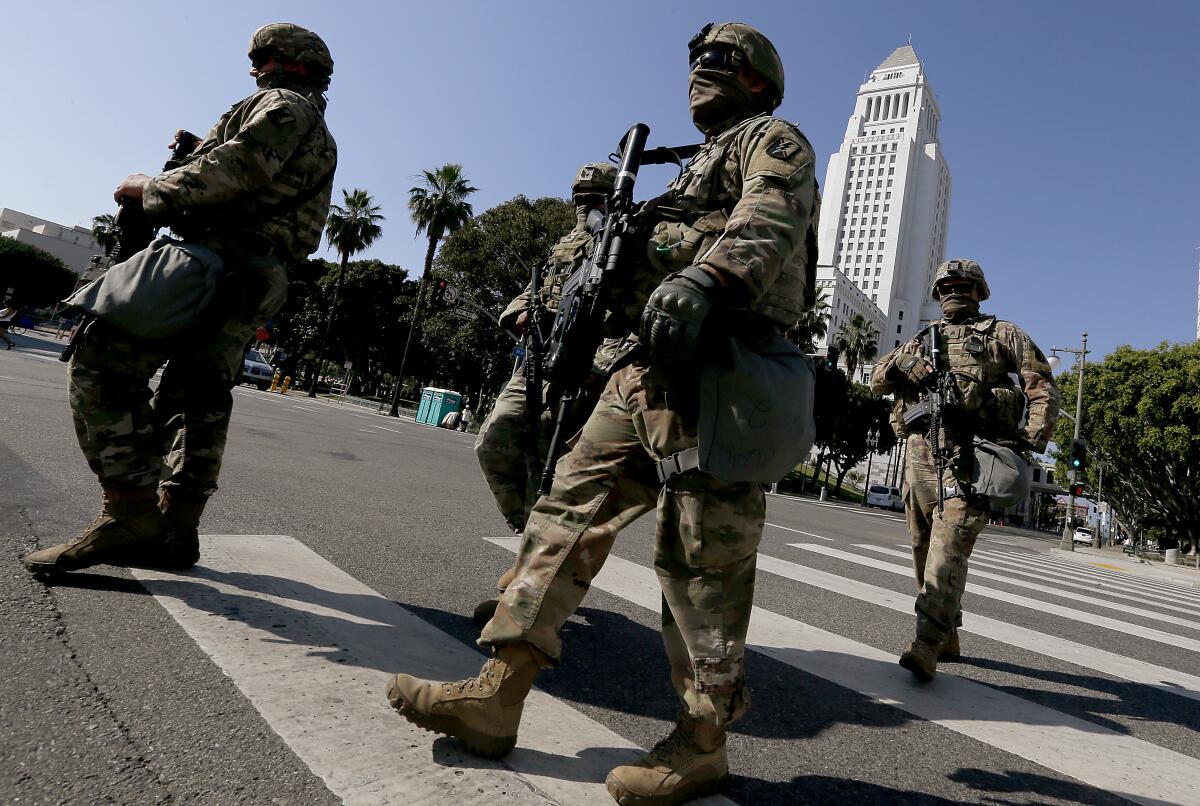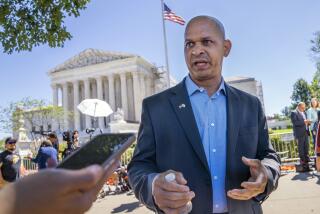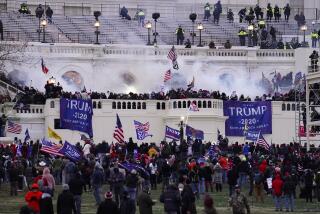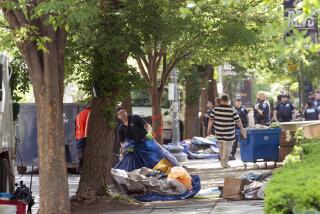As White Houseâs strong-arm tactics get pushback, Trump takes credit for peaceful protests

WASHINGTON â Asserting that âeverything is under perfect control,â President Trump claimed credit Sunday after a national wave of demonstrations against police abuses turned calmer, even as the White House faced fresh pushback over strong-arm tactics used against peaceful protesters.
Protests appeared peaceful Sunday, a day after riot police and National Guard troops largely stayed out of the way as chanting, sign-waving crowds marched and rallied in city after city against police brutality and endemic racism.
As he has during nearly two weeks of unrest, Trump again struck a stance of toughness, tweeting, âI want LAW & ORDER!â â a message his reelection campaign has embraced since the police killing of George Floyd in Minneapolis on May 25 sparked mass protests around the country and, in a few areas, vandalism and thefts.
The Trump administration has consistently portrayed a harsh response as commensurate with the threat of civil unrest and looting.
In California, officials announced Sunday that National Guard troops would be pulled out of cities across the state where they were deployed for the last week.
Trump tweeted that he had ordered National Guard troops to begin withdrawing from Washington, adding that they could âquickly returnâ if needed to support law enforcement.
The Pentagon later confirmed that Mississippi National Guard troops would return home Sunday night in case Tropical Storm Cristobal hit the Gulf Coast. Other units will leave Washington over the next 72 hours, leaving the District of Columbiaâs 1,200-member Guard unit.
In a conference call with reporters, Army Secretary Ryan McCarthy and Maj. Gen. William Walker, commander of the District of Columbia National Guard, defended the military deployment in the nationâs capital, saying the troops prevented protesters from getting onto the White House grounds.
McCarthy said officials âcame right up to the edgeâ of sending active-duty members of the 82nd Airborne Division into the city when violence broke out a week ago but ultimately held back. The 1,600 active-duty troops sent to the Washington area last week have all returned to their bases in New York or North Carolina, or are no longer on alert.
McCarthy also said the Pentagon would complete an investigation this week into why National Guard helicopters were flown at treetop level on June 1, terrifying residents and sending broken glass and debris flying.
In a round of television interviews Sunday, the presidentâs aides and surrogates again sought to deflect criticism of Trumpâs actions last week, which included his threat to send active-duty troops into American cities, his demand that governors use force to âdominate the streetsâ and his contention that a sojourn with his wife and son in a White House bunker during the protests last weekend was for âinspectionâ purposes.
On the highly fraught question of using active-duty military troops to put down civil unrest, Atty. Gen. William Barr said that âeveryoneâ in the administration agreed that it should be a âlast resort.â Trump had expressed no such reservations in bellicose comments to reporters Monday at the White House.
Barr, appearing on CBSâ âFace the Nation,â sought to brush aside controversy over the use of pepper pellets and rubber bullets against scores of demonstrators who had gathered Monday across from the White House.
Although witnesses and video recordings showed the protest was calm, Barr asserted that âthey were not peaceful protestersâ and that pepper spray was ânot a chemical irritant.â
Barr also denied that the protesters were cleared out by force so Trump could walk across the square moments later and pose with a Bible in front of historic St. Johnâs church, which had been damaged by fire the night before. The events âwere not connected,â he said.
Despite a persistent pattern of black deaths in police custody, Barr also said he didnât believe âthat the law-enforcement system is systemically racist.â He added, âThere are instances of bad cops.â
Trumpâs acting Homeland Security secretary, Chad Wolf, argued that a decisive response by law enforcement had turned the tide against the scattered looting and violence early last week.
âOver the last several days, weâve seen that violent protest and that violent looting and rioting diminish,â Wolf said on âFox News Sunday.â âItâs not by happenstance, itâs not by chance â itâs because we took early action.â
Protesters say that police violence against nonviolent demonstrators, documented in viral videos, underscored the need for police excesses to be reined in. And they noted this weekendâs peaceful protests absent widespread police presence.
Rep. Val Demings (D-Fla.), a former Orlando police chief who is seen as a potential running mate to presumptive Democratic nominee Joe Biden, praised officers with whom she had worked but said âsystemic racism is always the ghost in the room.â
âIf weâre going to solve some of Americaâs toughest problems, weâve got to be painfully honest about what those problems are,â she said on ABCâs âThis Week.â
In his tweets, Trump took aim several times at Biden, claiming the former vice president supports efforts to defund police, a key demand of some protesters.
The Biden campaign refused to comment Sunday about police defunding. But in his many statements about criminal justice reform both before and after Floydâs death, Biden has never endorsed the idea. He has called for increasing funding for community-oriented policing as part of a broad plan for criminal justice reform unveiled last year.
Public health experts warned that nearly two weeks of mass protests could lead to a new surge of coronavirus infections.
Scott Gottlieb, a former Food and Drug Administration commissioner, said the COVID-19 outbreak that had killed more than 110,000 Americans could gain new momentum, especially as shutdowns imposed in many states in late March have eased.
âWeâre certainly going to see transmissions coming out of these gatherings, thereâs no question about that,â Gottlieb said on âFace the Nation.â
He urged protesters to practice social distancing and use face coverings, and called on law enforcement officers to de-escalate physical confrontations that could lead to injuries and spread the virus.
Times staff writers Janet Hook and David S. Cloud contributed to this report.
More to Read
Get the L.A. Times Politics newsletter
Deeply reported insights into legislation, politics and policy from Sacramento, Washington and beyond. In your inbox three times per week.
You may occasionally receive promotional content from the Los Angeles Times.










